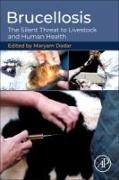Read more
Brucellosis: The Silent Threat to Livestock and Human Health offers an in-depth look into the challenges posed by brucellosis, including its prevention, control, diagnosis, and treatment in animals and humans. This zoonotic disease is a significant concern not only for animal health but also public health, creating an economic burden worldwide. As the first comprehensive reference on brucellosis in decades, this book provides valuable insights into combating and managing the disease in herds and communities. The book emphasizes the importance of the One Health approach, presenting a global perspective on brucellosis.
In addition, it discusses the contagious nature of the disease and its impact on livestock and humans, particularly those working in animal husbandry. The book serves as a foundation for new research, highlighting the need for further studies due to the lack of a cure for animals and the difficulties in treating humans.
List of contents
Introduction to Brucellosis1. Historical context and background.
2. Overview of Brucella species.
3. Epidemiology and global distribution.
4. Genotyping of Brucella spp.
5. Immunological responses to Brucella infection
Brucellosis in Animals6. Brucellosis in livestock (cattle, goats, sheep, swine, etc.).
7. Wildlife reservoirs and transmission.
8. Clinical signs and diagnosis in animals.
Zoonotic Transmission9. Human susceptibility to brucellosis.
10. Routes of transmission from animals to humans.
11. Occupational and recreational risks.
Clinical Manifestations in Humans12. Acute and chronic brucellosis.
13. Clinical symptoms and differential diagnosis.
14. Complications and long-term effects.
15. Diagnostic Tools and Techniques
16. Laboratory methods for detecting Brucella.
17. Serological tests, PCR, and culture.
18. Challenges and advancements in diagnosis.
Prevention and Control in Animals19. Vaccination strategies.
20. Biosecurity measures on farms.
21. Surveillance and eradication programs.
22. Brucellosis in low-resource settings and global impact
Prevention and Control in Humans23. Public health interventions.
24. Education and awareness campaigns.
25. Therapeutic approaches and drug development for Brucellosis
One Health Approach26. The interconnectedness of animal and human health.
27. Collaborative efforts to combat brucellosis.
28. Success stories and lessons learned.
Emerging Trends and Future Prospects29. Challenges posed by antibiotic resistance.
30. Potential impacts of climate change.
31. Research priorities and innovative solutions.
Brucellosis in food safety and processing32. Sources of food Contamination
33. Challenges in Detection and Regulatory Guidelines
34. Impact of brucellosis on Food Safety
Case Studies35. In-depth analysis of brucellosis outbreaks in specific regions or contexts.
36. Insights from experts in the field.
Conclusion37. The ongoing importance of addressing brucellosis.
38. Call to action for researchers, policymakers, and practitioners.
About the author
Dr. Maryam Dadar holds the position of Assistant Professor in the Department of Brucellosis at the Razi Vaccine and Serum Research Institute in Iran. Her extensive expertise lies in the field of microbiology and molecular biology, with a particular focus on brucellosis across various host organisms. Dr. Dadar has actively participated in multidisciplinary research and educational initiatives aimed at advancing the scientific foundations of veterinary science and molecular medicine related to brucellosis.

